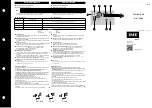
5
Instruction Booklet
IB0191002EN
Effective November 2019
EAFR-101C arc point sensor relay
user manual
EATON
www.eaton.com
3.3 Push-button description
The EAFR-101C contains one single push-button (SET) that can be
used for all operational functions of the relay . The push-button is
used to initialize the auto-configuration of the system (see Section
3 .3 .1) and for resetting the indicators and latched output relays .
3.3.1 Auto configuration (System setup)
When all sensors and binary lines have been connected, an
auto-configuration procedure must be executed . The initializa-
tion sequence is performed by pressing the “Set” button for two
seconds . The EAFR-101C sensor LEDs and all binary LEDs start
blinking . The relay scans these inputs to see if they are connected
and when an input is detected, the corresponding LEDs are illu-
minated to mark that a connection was found . The inputs without
connection continue blinking during the remaining three seconds .
After five seconds, all LEDs are turned off . During this system
setup, the dipswitch setting are also stored in non-volatile memory .
All sensor inputs will remain operational even when they are not
auto-configured . The auto-configuration is only used for self-supervi-
sion purposes .
ote:
N
To redo auto-configuration for a relay containing fewer connections
(binary inputs/outputs or sensors) than in a previously memorized set-up,
a dipswitch (any one) must be moved back and forth prior to perform-
ing auto-configuration . The timeout allowing a new configuration is one
minute . Reconfiguration with more connections is allowed without moving a
dipswitch .
3.4 Reset
All LED indications and latched trip relays are reset by pressing the
“SET” button for one second . Otherwise, the latched trip relays will
remain activated until auxiliary power is disconnected . All LED indi-
cations will remain active until reset is performed by the operator,
even when auxiliary power supply is disconnected (see Section 3 .6:
Non-volatile memory) .
Figure 3. EAFR-101C dipswitch SW1.
3.5 Dipswitch settings
EAFR-101C functionality, such as tripping logic, is configured using
dipswitch settings . Different trip configurations can be easily
programmed by selecting the appropriate dipswitch positions . This
gives users the flexibility to change settings dependent on the
application . Tripping may be selected based on arc light only or arc
light and current thresholds . Current threshold or other tripping
criteria may be applied to binary input BI1 for blocking a trip caused
by natural light sources . Dipswitches 1 and 2 are used as configura-
tion selection . Dipswitch 3 is for configuring BI5 to operate as a
Master Trip input or as a current information input . Dipswitch 4 and
5 are for setting binary input pairs 1-2 and 3-4 as active or inactive .
If a circuit breaker is connected to a binary input pair, the respective
dipswitch should be set to ON . Dipswitch 6 sets whether trip relay
outputs T1 and T2 latch or activate momentarily . Dipswitches 7 and
8 set whether sensor channels 1/2 and 3/4, respectively, pick up on
light only or on light and current .
Dipswitches are located at the back of the relay for easy access
(see Figure 3: EAFR-101C Dipswitch SW1 and Table 2: EAFR-101C
dipswitch setting selection for details of settings) .
S1/S2 Chan: light
S3/S4 Chan: light
T1/T2: latch
CB1 in use: yes
No
Non-latch
Light and current
Light and current
Configuration select:
8
7
6
5
4
3
2
1
CB2 in use: yes
Master trip
No
Current




































